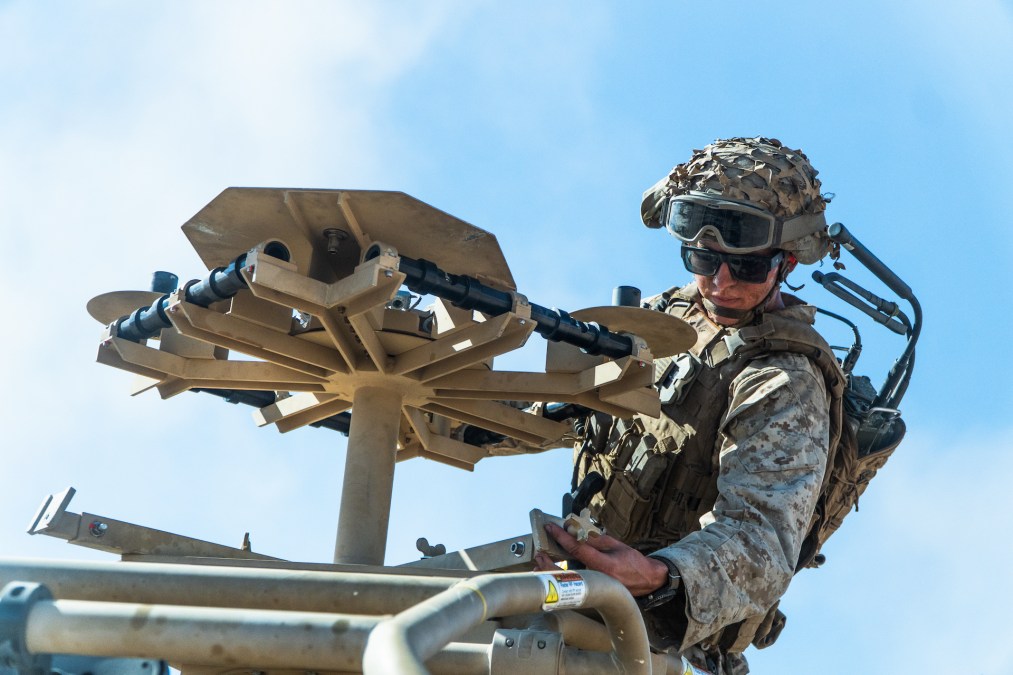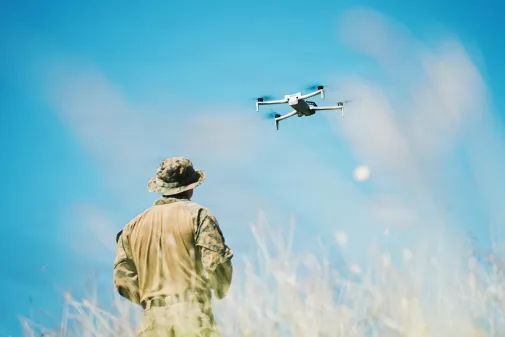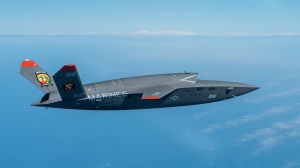Marines putting L-MADIS counter-drone system through tactics course for the first time

The Marine Corps this week is running one of its drone-killing tools through a key test aimed at helping the service formalize tactics and procedures and boost training.
The effort, which is taking place Oct. 7-12, marks the first time that the Light Marine Air-Defense Integrated System (L-MADIS), a ground-based solution that uses electronic signals to defend against small uncrewed aerial vehicles, has been used during a weapons and tactics instructor course, officials said.
The WTI course, hosted by the Marine Aviation Weapons and Tactics Squadron One (MAWTS-1), is a seven-week cycle that incorporates Marine Corps planning and implementation of advanced air and ground tactics through escalating scenarios to develop certified instructors that will serve as squadron training officers providing their units with proper training and evaluation to ensure readiness.
Officials explained that it’s important to be able to employ the counter-drone system in a WTI environment, in a controlled exercise scenario to capture lessons learned and begin to build doctrine and tactics for the system and the Marine Air Ground Task Force.
Having first deployed in 2019 under an urgent operational need, the tool hasn’t fully been put through its organizational paces yet.
The dangers posed by unmanned aerial systems system have garnered attention at the highest levels of the U.S. military, as leaders draw on observations from war zones around the world, including the Azerbaijan-Armenia conflict roughly five years ago, Ukraine’s ongoing war with Russia and crises in the Middle East.
“One of the biggest threats to us right now is probably UAS. And how do we counter that? L-MADIS is [the] answer right now,” Maj. Dusty Blanchard, ground-based air defense division head with Marine Aviation Weapons and Tactics Squadron One, said in an interview.
Blanchard said it’s important to have the L-MADIS system at the WTI course to employ it and give everyone an idea of how it works, providing the training team critical repetitions prior to deployment.
For many Marines and units, the first time they’ll have the opportunity to use the system is after they’ve already deployed.
Units “go through a new equipment training once it’s sent out to the fleet and that’s really their first time that they get to operationalize and use the system,” Blanchard said. “Coming out here, it gives them another rep and set at doing any kind of employment with that system, so that way they have a better understanding of once they go on deployment, how to use it and who to integrate with.”
The course provides an opportunity for the capability to integrate with others so Marines know what to expect and how to plan with the system for real-world operations, increasing the speed on a highly dynamic battlefield where troops might only have minutes to act.
“L-MADIS is typically isn’t seen by the rest of the deployers or the other units until it actually gets assigned to that specific unit that’s going to deploy. By being out here, it allows the students, along with the other field units that are at this course, to integrate and use it in a scenario-based exercise by anybody else seeing it on a deployment,” Blanchard said.
The WTI course simulates the condensed timelines for units while deployed and in operations where forces might only have a day or a few hours to work together and develop a plan for how to employ certain systems.
“What we’re going to get out of it is just the way to employ the L-MADIS in a more efficient manner, so that way, when we do happen to come on into a deployment, we’ll be able to use it more efficiently and skip the planning considerations for it, so we can just jump straight into, hey, this is what we have, this is what we can do and these are the planning considerations going forward,” Sgt. Angel LopezLopez, L-MADIS team leader with 3rd Low Altitude Air Defense Battalion, said. “It’ll introduce a smoother transition between us and the other agencies that we might be working with later on down the road to build that foundation of like, hey, this is what works, … this is how we employ and just make it a lot smoother on deployment so we don’t have as many hiccups when it’s actually in place in a real scenario.”
The Corps will get to refine tactics, techniques and procedures for the system as well, while also taking lessons learned from real-world use to see what works and what doesn’t work.
“That’s the best thing about coming out here … is that there really isn’t any written doctrine for this system. When we get the new equipment training, it’s up to us [to] just sort of build out our tactics, our techniques and procedures on how we’re going to counter UAS utilizing the L-MADIS,” Blanchard said. “That’s really the best part about coming out here to WTI, is we’re going to get multiple different evolutions and multiple different ways to refine those procedures.”
For the exercise itself, during what the Corps describes as “evolutions,” the system works up from smaller, less intense threats to the final day where it is really put through its paces.
The tool will go against real UAS to try to defeat them, although troops won’t get to live-test the full extent of L-MADIS’ capability given the sensitives of its power. For systems like this, a lot of approvals must be granted on the front end with other government agencies, such as the Federal Communications Commission, to run the electronic warfare components given that they can interfere with civilian assets and aircraft.
Following the WTI course, the instructors will gather all the information and figure out what they should eliminate or not focus on for the system to develop standard operating procedures for deployments.






